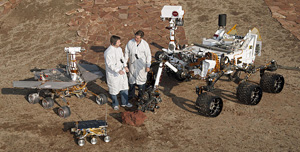Since it’s
spectacular landing on August 6, 2012, the NASA/JPL Curiosity rover has
been exploring Mars for 18 months. Curiosity had traveled over 3 miles
and witnessed 550 sunrises. While no little green men have come forth to
greet it, so far, Curiosity has found evidence that life could have
existed on Mars billions of years ago. But it has also shown that the
search for definitive evidence of extraterrestrial life may require
decades of additional exploration.

NASA’s exploration of Mars began 50 years ago with Mariner 4’s successful 1964 flyby.
Seven years
later, on November 14, 1971, NASA’s Mariner 9 became the first space
mission to orbit another world by overtaking the Soviets’ Mars 2
orbiter, which launched 11 days earlier but arrived 13 days later.
NASA’s
Viking 1 made the first successful Mars landing in 1975, and survived
for 2245 Martian days, which scientists call “sols”.
In 1997, NASA’s Sojourner became the first vehicle to drive on Mars.
Seven years later, NASA landed larger rovers, Spirit and Opportunity; the latter is still operational after 10 Earth years.

JPL scientists amongst duplicate Mars rovers from each generation
JPL, a
division of Caltech, designed, built, and operated all these NASA
missions. To date, no other nation has successfully landed a spacecraft
on Mars.
Spirit and
Opportunity proved liquid water had once existed on Mars, at least
sporadically. Water is a favorable solution for biochemical reactions,
and it provides two vital elements: hydrogen and oxygen. But, a
habitable environment requires much more. Life also requires the
availability of several other elements, an energy source, and a chemical
environment free of extreme acidity, alkalinity, or salinity.
Curiosity’s most important discoveries, according to NASA, are finding:
· habitats suitable for life
· stream beds of ancient rivers
· an unexpected diversity of environments
· an absence of methane
· and perilous radiation levels
Let’s discuss these further.
Curiosity
has shown that habitable conditions once existed, at least briefly in
some limited areas. It found all of life’s most essential elements:
hydrogen, carbon, oxygen, nitrogen, phosphorous, and sulfur. Curiosity
also found locations with favorable chemistry and energy sources. Such
favorable conditions, which are rare on Mars, might have been adequate
for microbial life. No serious scientist still believes that advanced life forms ever existed on Mars.
One
possible Eden has been imaginatively named Sheepbed in Yellowknife Bay
(it has no sheep, water, or knives). Clay minerals there suggest
abundant water with neutral pH and low salinity existed billions of
years ago. Radioisotope analysis shows that the surface here has been
exposed to cosmic and solar radiation for only 50 to 110 million years.
It may have been deeply buried billions of years ago, and recently
exposed by wind-driven erosion. Also present are minerals with a variety
of oxidation states that microbes could have exploited for chemical
energy. A paper by JPL scientists led by Caltech Professor of Geology
John Grotzinger estimates that liquid water existed here for between
hundreds of years and tens of thousands of years. If what we now see was
just part of a much thicker deposit, this area could have been
habitable for much longer. By comparison, the origin of life on Earth is
generally believed to have taken hundreds of millions of years.
Curiosity
found that methane, a signature of most life forms, is conspicuously
absent from the Martian atmosphere. Less than 20 tons of methane per
year are entering Mars’ atmosphere — 50 million times less than on Earth
— diminishing the possibility of current or geologically recent life.
Radiation
levels at Mars’ surface, as measured by Curiosity, are much higher than
some hoped. Mars lacks both Earth’s robust atmosphere and magnetic
field, which greatly reduce our radiation exposure. Any future manned missions to Mars will require massive shielding.
Curiosity was designed to search for habitats suitable for life, but isn’t equipped to search for evidence of life
itself. Curiosity has shown that such evidence would rapidly decompose
at or near the surface. Future Mars missions must target ancient aqueous
environs that were deeply buried billions of years ago (when there was
water) and were recently exposed. This will be a severe challenge. Earth
is far more benign. Thousands of scientists have scoured Earth for over
100 years, searching for signs of ancient microbial life, and yet the
evidence remains debatable. The odds seem daunting that one robot could
find compelling evidence within one tiny part of a more hostile planet
100 million miles away.
Yet, Mars is our best chance to find life beyond Earth.
Best Regards,
Robert
Feb 26th, 2014
|